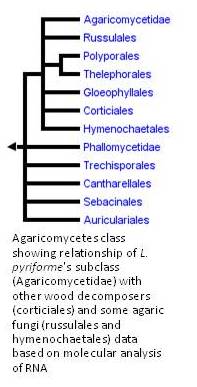 Basic Taxonomy
Basic Taxonomy
Domain - Eukarya
Kingdom - Fungi
Phylum - Basidiomycota
Class - Agaricomycetes
Order - Agaricales
Family -
AgaricaceaeGenus -
Lycoperdon
Species - L. pyriforme photo from tree of life site
Taxonomic Characteristics
Domain: Eukarya
Organisms in this domain
all have a membrane bound nucleus in addition to distinct
sub-cellular organelles.
Kingdom: Fungi
Since adult fungi are non-motile, they must live in/on their food source
in order to take in nutrients.
When depleted, fungi must then reproduce to establish
offspring in new nutrient-rich areas.
The use of exoenzymes is also unique to fungi.
Unlike animals, fungi first secrete these enzymes to
digest their food, then they ingest it.
*Note
that a few fungi may have a motile phase, but none
are freely motile for entire lifecycle*
Phylum: Basidiomycota
The basidiomycota compose a large percentage of the fungi with
around 30,000 identified species (over a third of all named
fungi).
One identifiable feature of this phylum is the unique production
of its sexual spores.
Given the name basidiospores, these sexual spores are
born externally on club-shaped cells called basidia.
Fungi of this group can (albeit rarely) reproduce
asexually. Upon
emergence from spores (germination), the organism may develop
into unicellular yeast
(typically haploid and non-nucleated) or develop into septate
hyphae.
Class: Agaricomycetes
With around 16,000 identified species, the
Agaricomeycetes class of basidiomycota is not only the most
populous, but also seem to be the most recognized class of
fungi. This is
primarily due to the extraordinary diversity of observed
reproductive structures, or mushrooms.
Nearly all members exist as flamentous septate hyphae
rather than as yeast.
Although primarily wood-decayers, members of this class
have been observed to survive in nearly all terrestrial
ecosystems as well as a few aquatic ecosystems.
"pseudo" class: Gasteromycetes
The
term Gasteromycetes is often used as the class name for L.
pyriforme, but it is important to note that this term is not
an official taxonomic term.
Rather, it has been applied to certain basidiomycota that
portray some common characteristics.
One of which is the maturation of basidia inside of a
closed are prior to maturation of the fruiting body (mushroom).
Stated in another way, the sexual basidiospres mature
before being introduced to the outside air.
Again, don’t forget that this is not a true class of
fungi since members are not closely related to each other.
Order: Agaricales
This monophyletic group of approximately 8500 species represents
the largest order of the Agaricomycetes class (Binder et al.,
2005). A typical
feature of these fungi is the presence of gill-like structures.
Otherwise, classification of an unknown fungus into this
order is dependant upon ruling out key characteristics of other
orders. There is
also no typical habitat for this order; they survive in pretty
much any terrestrial location.
Many (but not all) Agaricales form associations with
plants in the form of mycorhizzae.
These associations benefit both organisms involved, which
is known as a mutualistic symbiosis.
Family: Agaricaeae
This family consists of about 85 genera
and 1300 fungal species.
This family contains the now eliminated families of now contains
organisms that used to be tolustomataceae, lepiotaceae
and
lycoperdaceae, the last of which
was known as the true-puffball family. Many fungi
in the agaricaceae stuff their
spores inside a sandwich of skin layers, thus not allowing
access
to the outside world during development.
Eventually when the fungus is ready to release its
spores, the outer layer rips and spits out a cloud of spores,
resembling a *puff*.
Genus: Lycoperdon
The lycoperdon genus is the first taxonomic group in which the
individuals share a common habitat which consists of fields and
forests. They also
contain filamentous strings which offer support structure.
This is covered in more detail in the
structure page.
Species: L. pyriforme
Here we have the famous wolf-fart puffball!
This organism is described further in the linked pages.
Many people seem to find the
structure of this organism to be especially interesting.
